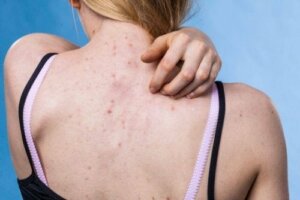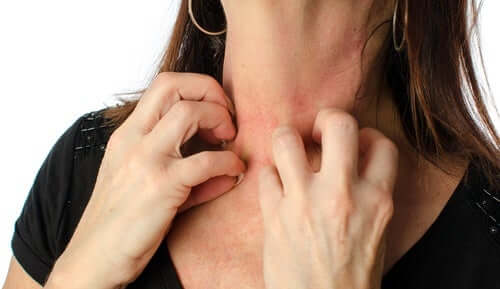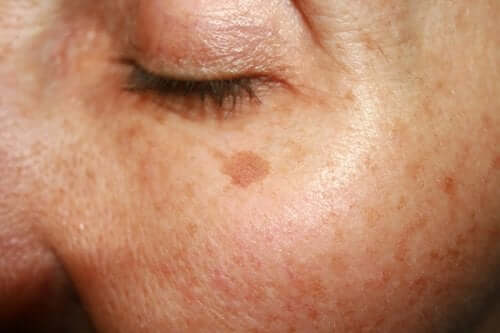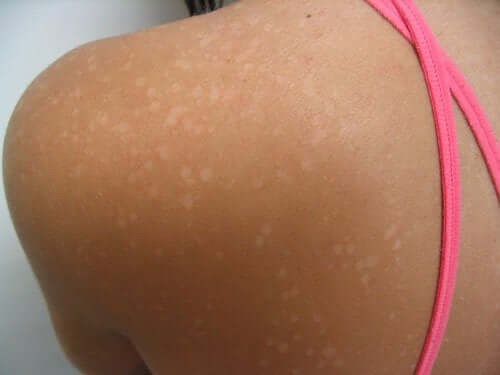Tips to Prevent Skin Diseases


Written and verified by the nutritionist Eliana Delgado Villanueva
The skin is the most visible organ and possibly one of the most vulnerable to suffering change. Despite the fact that skin diseases usually aren’t serious, the symptoms they cause are bothersome. Do you know how to prevent the most common skin diseases?
No other organ in the human body changes as much as the skin does. This is because the skin is exposed to multiple internal and external influences. Below, discover some tips to prevent skin diseases.
What are skin diseases?
The skin is the largest organ in the body, covering and protecting it. Thus, some of its main functions are:
- It maintains body fluids inside the body, preventing dehydration.
- Protects you against bacteria and viruses that can cause infections.
- Helps you perceive the external world. For example, whether it’s hot or cold, or wet or dry.
- It regulates body temperature.
- Makes vitamin D after sun exposure.
Anything that irritates, clogs, or inflames your skin can cause symptoms such as redness, swelling, burning, and itching.
You should also read: 5 Ways Skin Conditions Can Tell You Something Is Wrong
Tips to prevent some skin diseases
Most of the time, prevention is the best way to control skin problems. Sometimes, pain or discomfort are the first signs of the start of a skin condition. It lets you know that you have these problems, even if they aren’t visible.
Below, we share general information about common skin conditions and how to control them:
Skin rashes

Rashes are red, painful, and itchy. Some rashes can also lead to blisters or raw skin parts. In addition, they’re a symptom of many different clinical pictures.
People may experience a rash that looks like acne or measles. There are several ways to control a rash based on its severity:
- Because many different things can cause rashes, it’s important to discover what type you’re suffering from before treating it. If it’s a severe rash, it doesn’t improve, or you’re suffering from other symptoms, you should see a doctor.
- Treatments include moisturizers, lotions, baths, cortisone creams that relieve inflammation, and antihistamines that relieve itching.
How to prevent skin diseases: Sun allergy
This term encompasses different skin diseases, such as polymorphous light eruption (PLE), solar urticaria (SU), actinic prurigo, or porphyria.
When some people sunbathe, they suffer from hives or pimples on the face, neckline, and arms. If this happens to you, you need to consult your dermatologist to rule out more serious conditions. Below, discover recommendations that may prove helpful:
- Avoid sun exposure between eleven in the morning and four in the afternoon
- Wear a hat
- Don’t expose yourself to the sun when the allergy begins to appear
- Cover the affected areas
- Use special sunscreen for sun allergies
Sunspots or melasma

Changes in pigmentation increase during the summer due to sun exposure. Below, we share some tips to help you prevent them:
- Keep an eye on your upper lip area, cheeks, and forehead, as they’re the most affected areas.
- Avoid irritating the area, as this can lead to new sunspots or make pre-existing ones spread.
- It’s essential to apply sun protection measures and use caps, hats, or sunglasses. In addition, you should try to stay in shaded areas.
- Apply the sunscreen 20 to 30 minutes before sun exposure and reapply every two hours to maintain the protective effect.
- Don’t use irritating cosmetic products, as the sun can activate some and cause inflammatory reactions.
This article may interest you: The Harmful Effects of the Sun on Your Skin
Athlete’s foot
This skin condition is a fungal infection that affects the feet. It especially affects the spaces between the toes. To prevent athlete’s foot, we recommend that you:
- Dry your feet well after washing them, especially between your toes.
- Change your socks and shoes every day.
- Don’t leave your feet in hot water for a long time because this facilitates fungal penetration.
- Avoid walking barefoot around public pools and showers.
- Moisturize your feet every day.
- If you have an infection, using an antifungal cream for a few days is usually enough.
- Take antiseptic foot soaks at the end of the day.
Back spots or tinea versicolor

This is another type of fungal infection that mostly affects men between the ages of 15 and 30 who live in hot and humid countries. It causes the appearance of well-defined rounded dark brown or pinkish white spots covered with scales on the thorax or limbs. Regarding this condition, we recommend:
- Firstly, be careful with sweat, sebum, and high temperatures, as they’re optimal conditions for fungal growth.
- During the summer, avoid tight-fitting clothing, as well as clothing that isn’t very breathable.
- Also, clean excess sebum and sweat with a mild cleansing lotion.
- During the spring and summer, apply topical tinea versicolor medications in the form of soaps or shampoos. Use them once or twice a week to prevent recurrences.
- Using an antifungal cream may be enough to heal the condition. However, the most resistant fungi may require oral drugs.
All cited sources were thoroughly reviewed by our team to ensure their quality, reliability, currency, and validity. The bibliography of this article was considered reliable and of academic or scientific accuracy.
- Bolognia, J. L., Schaffer, J. V., & Cerroni, L. (Eds.). (2018). Dermatología. Elsevier Health Sciences.
- Fitzpatrick, T. B. (2009). Dermatología en medicina general. Ed. Médica Panamericana.
- Mascaró, J. M. (2003). Medicina Cutánea: recuerdos de ayer, realidades de hoy. Medicina Cutánea Ibero-Latino-Americana, 31(4), 219-220.
- Alergia al sol. Mayo Clinic. https://www.mayoclinic.org/es-es/diseases-conditions/sun-allergy/symptoms-causes/syc-20378077
- Denise Aaron. 2018. Tiña versicolor (Pitiriasis versicolor). Manual MSD. https://www.msdmanuals.com/es-ar/hogar/trastornos-de-la-piel/infecciones-f%C3%BAngicas-de-la-piel/ti%C3%B1a-versicolor
- Pie de atleta. MedlinePlus. https://medlineplus.gov/spanish/ency/article/000875.htm
- Melasma. MedlinePlus. https://medlineplus.gov/spanish/ency/article/000836.htm
- Consejos de la AEMPS sobre protección solar. Asociación Española de Medicamentos y Productos Sanitarios. https://www.aemps.gob.es/cosmeticosHigiene/cosmeticos/docs/proteccion_solar.pdf
- Benedetti, Julia. 2019. Estructura y funcionamiento de la piel. Manual MSD. https://www.msdmanuals.com/es-ar/hogar/trastornos-de-la-piel/biolog%C3%ADa-de-la-piel/estructura-y-funcionamiento-de-la-piel
This text is provided for informational purposes only and does not replace consultation with a professional. If in doubt, consult your specialist.








